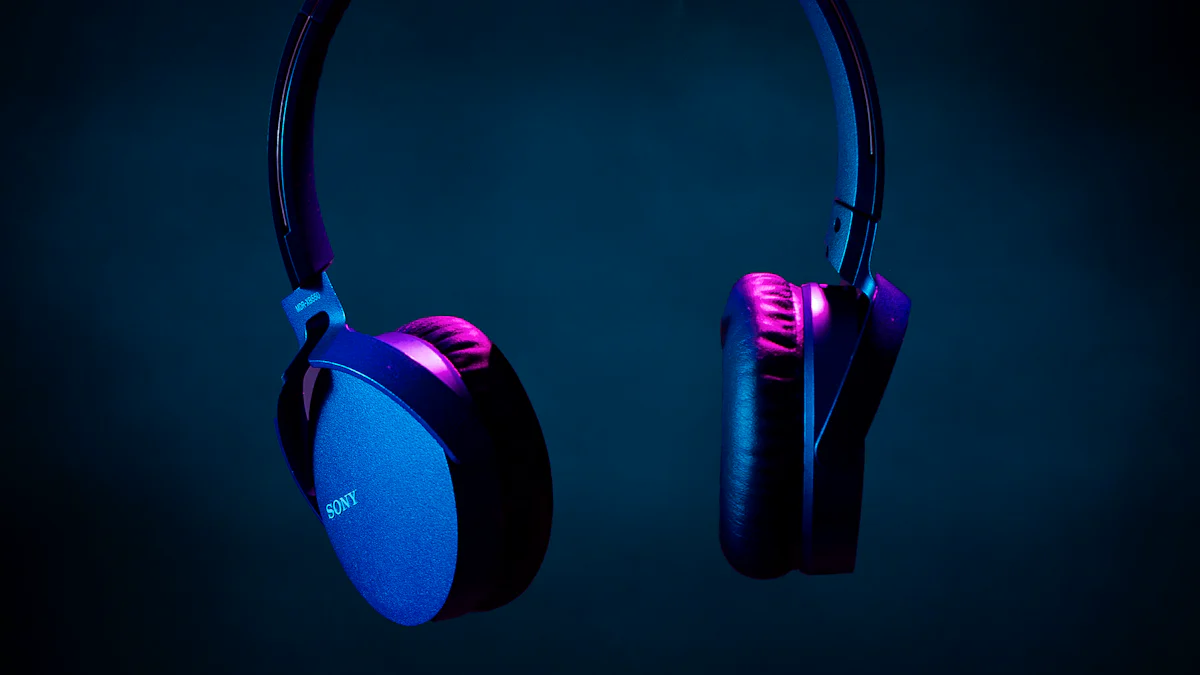How Does Noise-Cancelling Technology Function in Headsets?

Have you ever wondered how your Bose QuietComfort or Sonos Ace headphones make the world around you disappear? It's all about the magic of Active Noise Cancellation (ANC). This technology uses microphones to pick up environmental noise and then generates sound waves that are the exact opposite, effectively canceling out the unwanted sounds. Imagine sound wave peaks meeting their perfect match in valleys, neutralizing each other. This is how active noise cancelling works. Whether you're using Bose Noise Cancelling Headphones or the Coolpo Ignite Headset: microphone-focused headset with noise cancellation for remote work, the principle remains the same. With Adjustable Active Noise Cancellation, you can tailor your listening experience to suit your environment.
Basics of Noise Cancellation
Understanding the Basics of Noise Cancellation can transform your listening experience. Let's dive into how this fascinating technology works.
Sound Waves and Interference
Sound waves are like ripples in a pond. They travel through the air, creating peaks and valleys. When two sound waves meet, they can either amplify each other or cancel each other out. This is where noise cancelling technology leverages the concept of interference. By generating sound wave peaks that match the valleys of unwanted noise, your headphones can effectively silence the world around you.
Peaks and Valleys in Sound Waves
Imagine you're at a concert. The music creates sound wave peaks that reach your ears. If another wave with matching valleys meets these peaks, they cancel each other out. This is the magic behind Active Noise Cancellation. Your ANC headphones use this principle to create a serene listening environment, even in noisy places.
Components of Noise Cancelling
The components of noise cancelling are crucial for its effectiveness. ANC headphones use sound technology to achieve this.
Role of Microphones and Earpiece Design
Microphones play a vital role in Active Noise Cancellation. They pick up environmental noise and send it to the ANC chipset. This chipset analyzes the noise and generates an anti-noise signal. The design of the earpiece also matters. It helps block out environmental noise physically, enhancing the cancellation effect. Brands like Bose QuietComfort Ultra Headphones and Sonos Ace have perfected this design, offering you an immersive audio experience.
ANC earbuds like the Bose QuietComfort Ultra Earbuds also use this technology. They fit snugly in your ears, providing both active and environmental noise reduction. Whether you're using AirPods Pro or Aliph Jawbone, the principle remains the same. The ANC system ensures that you hear only what you want to hear.
Active vs. Passive Noise Cancellation

When it comes to blocking out unwanted sounds, you have two main options: Active and Passive Noise Cancellation. Each method has its unique approach and effectiveness.
How Active Noise Cancellation Works
Active noise cancellation (ANC) is like having a personal sound engineer in your headphones. It uses a sophisticated system of microphones and speakers to combat environmental noise. Here's how it works:
-
Microphones: These tiny devices pick up the sound waves from the surrounding environment. They detect the peaks and valleys of the noise, which is crucial for the next step.
-
Sound Processors: Once the microphones capture the noise, the sound processors get to work. They analyze the incoming sound and generate an anti-noise signal. This signal is the exact opposite of the detected noise, effectively canceling it out.
-
Speakers: The speakers in your ANC headphones play this anti-noise signal, creating a serene listening experience. This process is particularly effective against low-frequency sounds like traffic or airplane engines.
The Bose QuietComfort series is a prime example of how active noise cancellation can transform your audio experience. With ANC, you can enjoy your music without the distraction of background noise.
Active Noise Cancelling Mechanisms
The mechanisms behind active noise cancelling are both fascinating and complex. The ANC system relies on continuous monitoring and adjustment to ensure optimal performance. This technology requires power, which is why you'll often need to charge your ANC headphones. Despite this, the payoff is significant, especially in noisy environments.
Passive Noise Cancellation Explained
On the other hand, passive noise cancellation takes a simpler approach. It doesn't rely on electronics or power. Instead, it uses physical barriers to block out sound. Here's how it works:
-
Earpiece Design: The design of the earpiece plays a crucial role. Over-ear headphones, like the Sonos Ace, use thick padding to create a seal around your ears. This seal helps block out mid- to high-frequency sounds.
-
Noise Masking: By physically blocking sound, passive noise cancellation can effectively reduce unwanted noise. It's like closing a door to keep out the noise from another room.
Noise Masking and Earpiece Design
The effectiveness of passive noise cancellation largely depends on the design of the headphones. A snug fit ensures that less sound leaks in, enhancing the overall experience. While it may not be as effective against low-frequency sounds as active noise cancellation, it excels at reducing mid- to high-frequency noises.
Effectiveness of Noise-Cancelling Headphones
When you slip on a pair of ANC headphones, you might wonder where they work best. These headphones shine in specific environments, making them a must-have for many.
Ideal Environments for ANC Headphones
-
Airplanes: Ever been on a long flight with the constant hum of the engines? ANC headphones can transform your flying experience. They excel at reducing low-frequency sounds, like engine noise, allowing you to enjoy your music or movies without distraction. The Bose QuietComfort series is particularly popular among frequent flyers for this reason.
-
Public Transport: Whether you're on a bus or a train, environmental noise can be overwhelming. ANC headphones help create a personal bubble of silence, making your commute more enjoyable. You can focus on your podcast or audiobook without the chatter and clatter around you.
Open-plan offices can be noisy, with conversations and phone calls happening all around. ANC headphones help you concentrate by minimizing these distractions. They allow you to dive into your work without being interrupted by the hustle and bustle of the office environment.
Limitations and Challenges
While ANC headphones are fantastic, they aren't perfect. Understanding their limitations helps you make the most of them.
-
High-Frequency Noise: ANC technology works best with low-frequency sounds. High-frequency noises, like sudden loud conversations or clinking cutlery, can still seep through. This is because the ANC system primarily targets the peaks and valleys of low-frequency sound waves.
-
Fit Issues: The effectiveness of ANC headphones also depends on how well they fit. A snug fit ensures that environmental noise is blocked out physically, enhancing the active noise cancellation. If your headphones don't fit well, you might not experience the full benefits of ANC.
Survey Results: Many users report that ANC headphones significantly improve their audio experience and reduce stress caused by noise. However, they also note that a proper fit is crucial for optimal performance.
Why Some Noise Might Still Be Heard
You might wonder why some noise still sneaks through your ANC headphones. Despite the impressive technology, noise-canceling isn't foolproof. Let's explore why this happens.
Understanding Limitations of Noise Cancellation
ANC technology excels at reducing steady, low-frequency sounds like the hum of an airplane engine or the rumble of a train. However, it struggles with sudden, high-frequency noises. Imagine you're in a bustling café. The chatter and clinking cutlery might still reach your ears. This happens because ANC technology primarily targets consistent sound waves, not abrupt ones.
Sudden Noises and Headphone Fit
Sudden noises, like a door slamming or someone shouting, can bypass ANC. These sounds don't have the predictable patterns that ANC systems need to generate effective anti-noise signals. Additionally, the fit of your headphones plays a crucial role. A snug fit enhances both active and environmental noise cancellation. If your headphones don't seal well, more environmental noise can seep in, reducing the effectiveness of the ANC.
Did you know? Some users report a slight hissing sound or loss of clarity when noise cancellation is active, especially in lower-end models. This is a trade-off for the peace and quiet ANC provides.
Modern ANC headphones often come with various modes, including adaptive ANC. This feature adjusts the noise-canceling effect based on your environment, offering a more tailored experience. Yet, even with these advancements, Modern ANC headphones have their limits. It can't eliminate all noise in every circumstance. Factors like frequency and intensity of the noise affect its effectiveness.
Future of Active Noise Cancellation

Imagine a world where your headphones not only cancel out noise but also adapt to your surroundings in real-time. The future of Active Noise Cancellation (ANC) is heading in that direction, with exciting advancements on the horizon. Let's explore how emerging trends are shaping this technology.
Emerging Trends in Noise Cancellation Technology
The evolution of ANC technology is driven by the integration of smart devices and artificial intelligence (AI). These innovations promise to enhance your listening experience by making noise cancellation more intuitive and effective.
Integration with Smart Devices and AI
-
Real-Time Adaptability: AI-based noise cancellation technologies offer real-time processing and adaptability. Unlike traditional ANC, which excels at reducing specific types of noises, AI can continuously analyze your environment and adjust noise suppression levels accordingly. This means your headphones could automatically switch modes when you move from a quiet library to a bustling street.
-
Smarter Algorithms: Future ANC headphones might use smarter algorithms to fine-tune noise cancellation. These algorithms could learn from your listening habits and preferences, providing a personalized audio experience. Imagine your headphones knowing when to prioritize music over environmental noise or when to let in important sounds like a car horn for safety.
-
Multiple Microphones: Advancements in ANC technology include the use of multiple microphones for improved noise cancellation. By capturing sound waves from various angles, these microphones can create a more accurate anti-noise signal. This results in better handling of environmental noise, even in complex soundscapes.
-
Integration with Smart Devices: As ANC technology becomes more integrated with smart devices, you can expect seamless connectivity and control. Picture adjusting your noise cancellation settings through a voice assistant or an app on your smartphone. This level of integration enhances convenience and allows for a more tailored experience.
Did you know? Some ANC headphones already feature adaptive algorithms that adjust noise cancellation based on your surroundings. This technology is still evolving, but it holds great promise for the future.
The future of ANC is not just about blocking out noise; it's about creating a harmonious balance between your audio experience and the world around you. With AI and smart device integration, ANC technology is set to become more intelligent and responsive, offering you a truly immersive and personalized listening journey.
Noise-cancelling headphones have revolutionized how you experience sound. By using ANC technology, these devices actively combat environmental noise, allowing you to enjoy music or silence without distractions. As technology advances, expect even more sophisticated features, like AI integration, to enhance your auditory experience. When choosing ANC headphones, consider your specific needs and environments, whether it's for travel, work, or leisure. Brands like Bose offer excellent options, but the right choice depends on your lifestyle and preferences. Remember, the future of noise cancellation promises even greater control over sound waves and environmental noise.
See Also
Comparing Jabra PanaCast 50 And Coolpo AI Huddle Camera
Selecting The Best 360 Degree Speakers: Robot Or Human
A Comprehensive Guide To Mastering AV Capabilities
Discovering The Perfect Video Conferencing Camera For Meetings
